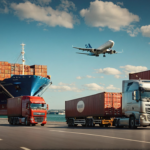Maritime transportation is beginning to show the first signs of weakening. After two years of record results driven by an increase in volumes, prices, and consecutive port delays.
Especially now, with consumers changing their spending patterns, rampant global inflation, and the fear of an impending recession. The signs point to the coming market normalization that industry executives have alluded to in recent months.
However, significant uncertainties affect maritime transportation recently, when we talk about demand and supply the situation is unprecedented. While results are still high in comparison to the pre-COVID market; a notable impact has hit rates and prices as well as activity in the asset markets.
Even though volumes, which are the drivers of rates and pricing, profitability, and congestion, were down in March 2022 in comparison to 2021. In addition, the volumes in Oceania and Europe were particularly weak in March 2022. North America continued increasing its production, but they were also showing slower growth rates in many places.
Changes in Maritime Transportation
Companies have had to accept much shorter charter periods, which on average have now fallen to two years from a top of four years in mid-2021. At the same time, second-hand prices seem to have peaked for the time being and the number of transactions has decreased significantly, while newbuilding contracting, and price increases have also slowed in 2022.
Aside from the uncertainties in maritime transport, contracting activity has been high since the fourth quarter of 2020 and 6.3 million TEU in new contracts have been signed since then. The deliveries of these ships will start in 2023, but many will happen in 2024 and 2025.
Possibly, the global container fleet will grow by 3 percent in 2022; however, that growth will accelerate in 2023 to nearly 8 percent, reaching 27.4 million TEUs by early 2024. Some growth could be offset by demolition activity, which while slowed during peak demand could be boosted by new environmental regulations. Such as EEXI (Energy Efficiency eXisting ship Index) and CII (Carbon Intensity Indicator), due to come into effect in 2023.
Many indicators in maritime transportation point to a slowdown in demand growth; especially for regional and head-haul trade during 2022 and 2023. All this combined with fleet growth and new environmental requirements on shipping, promises a period full of opportunities in the supply cha
What is necessary?
With so many opportunities and challenges presenting themselves, you must prepare and your supply chainmust be resilient. For this, well-established integration, visibility and communication are essential.
You will achieve all this with our smart operating system, click here and check it out.


















